engine coolant HONDA ELEMENT 2010 1.G Owners Manual
[x] Cancel search | Manufacturer: HONDA, Model Year: 2010, Model line: ELEMENT, Model: HONDA ELEMENT 2010 1.GPages: 342, PDF Size: 5.76 MB
Page 4 of 342

EngineAdding Engine Coolant ...........254
Coolant Temperature Gauge ....67
If it Won't Start ........................289
Malfunction Indicator Lamp ............................. 58, 296
Oil Life Indicator .....................243
Oil Pressure Indicator .......58, 295
Oil, What Kind to Use .............251
Overheating ............................ 293
Specifications .......................... 308
Speed Limiter ..................218, 221
Starting ................................... 216
Engine Coolant .......................... 254
Engine Number .........................307
Ethanol in Gasoline ....................198
Evaporative Emissions Controls .................................. 316
Exhaust Fumes ............................ 52
Expectant Mothers, Use of Seat Belts by .................................... 16
F
Fan, Interior ............................... 105Features
..................................... 103
Filters
Dust and Pollen .......................269
Oil ........................................... 252
Flashers, Hazard Warning ...........73
Flat Tire, Changing a .................283
Floor Mats ................................. 268
Fluids Automatic Transmission .........256
Brake ...................................... 258
Clutch ..................................... 258
Location .................................. 250
Manual Transmission ..............257
Power Steering ........................260
Rear Differential ......................258
Windshield Washer .................255
FM/AM Radio Reception ...........186
Folding the Rear Seats .................88
Four-way Flashers ........................73
Front Airbags ........................... 9, 25
Front Seat
Adjusting .................................. 83
Fuel ............................................ 198
Check Fuel Cap Message ........66
Economy ................................. 202
Fill Door and Cap ....................199Gauge
...................................... 66
Low Fuel Indicator ...................61
Octane Requirement ...............198
Reserve Indicator .....................61
Tank, Filling the ......................199
Fuel Economy ............................ 202
Fuses, Checking the ..................298
G
Gas Mileage, Improving .............203
Gasoline ..................................... 198
Gauge ...................................... 66
Low Fuel Indicator ...................61
Octane Requirement ...............198
Tank, Refueling .......................199
Gas Station Procedures ..............199
Gauges Engine Coolant Temperature ...67
Fuel .......................................... 66
Odometer ................................. 65
Outside Temperature Indicator ............................... 68
Speedometer ............................ 64
Tachometer .............................. 64
Index
IV
Page 8 of 342

Protecting Children......................35
General Guidelines ..................35
Protecting Infants .....................40
Protecting Larger Children ......49
Protecting Small Children ........41
Using Child Seats with Tethers ................................. 48
Using LATCH .......................... 44
R
Radiator Overheating .................293
Radio/CD Sound System ...........109
Radio Theft Protection ...............188
Readiness Codes ........................319
Rear Differential Fluid ................258
Rear Lights, Bulb Replacement ........................... 266
Rear Seat, Folding ........................88
Rearview Camera and Monitor .................................. 196
Rearview Mirror ........................... 93
Rear Window Defogger ................74
Rear Window Wiper and Washer ..................................... 70Reclining the Front Seats
.............87
Recommended Shift Speeds .......218
Refueling .................................... 199
Reminder Indicators .....................58
Remote Audio Controls ..............191
Remote Transmitter .....................77
Replacement Information
Dust and Pollen Filter .............269
Engine Oil and Filter ...............252
Fuses ...................................... 298
Light Bulbs ............................. 261
Schedule ................................. 249
Spark Plugs ............................. 308
Tires ....................................... 274
Wiper Blades .......................... 269
Replacing Seat Belts After a Crash ........................................ 20
Reporting Safety Defects (U.S. Vehicles) ................................ 324
Reserve Tank, Engine Coolant ............................ 201, 254
Restraint, Child ............................ 35
Reverse Gear Position ................220
Reverse Lockout ........................217
Rotation, Tire ............................. 274S
Safety Belts
.............................. 8, 18
Safety Defects, Reporting (U.S. only) ....................................... 324
Safety Features .............................. 7
Airbags ................................. 9, 22
Head Restraints ........................13
Seat Belts ........................ 8, 14, 18
Seats & Seat-Backs ..............11, 12
Safety Labels, Location of .............53
Safety Messages ..........................iii
Seat Adjustments .........................83
Seat Belts ................................. 8, 18
Additional Information .............18
Advice for Pregnant Women ....16
Automatic Seat Belt
Tensioners ........................... 20
Cleaning .................................. 268
Lap/Shoulder Belt ..............14, 19
Maintenance ............................ 20
Reminder Indicator and Beeper ............................. 18, 58
System Components ................18
Use During Pregnancy .............16
Index
VIII
Page 83 of 342
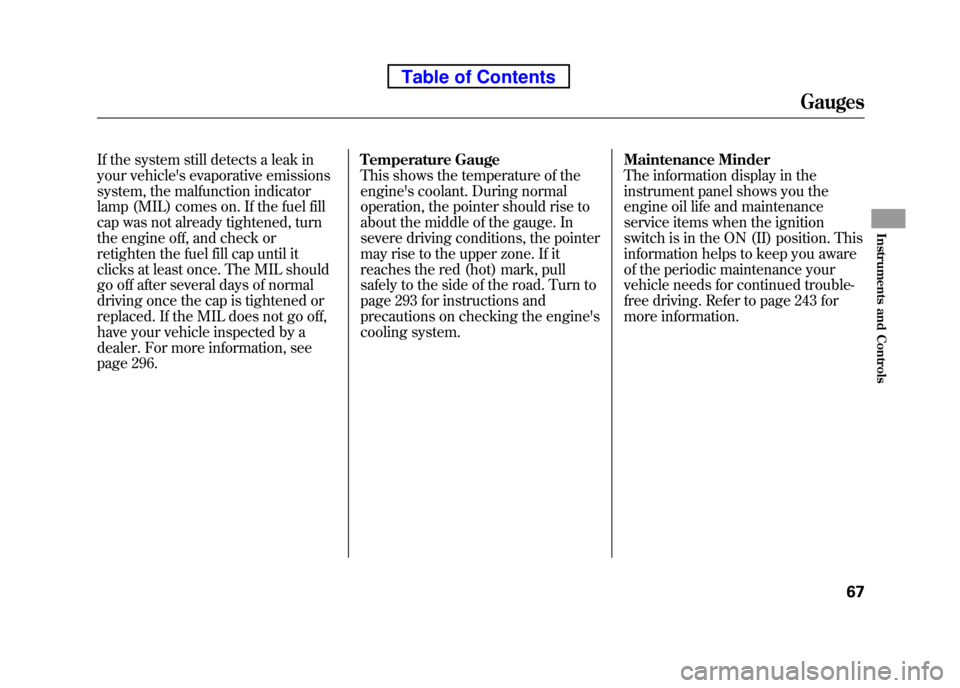
If the system still detects a leak in
your vehicle's evaporative emissions
system, the malfunction indicator
lamp (MIL) comes on. If the fuel fill
cap was not already tightened, turn
the engine off, and check or
retighten the fuel fill cap until it
clicks at least once. The MIL should
go off after several days of normal
driving once the cap is tightened or
replaced. If the MIL does not go off,
have your vehicle inspected by a
dealer. For more information, see
page 296.Temperature Gauge
This shows the temperature of the
engine's coolant. During normal
operation, the pointer should rise to
about the middle of the gauge. In
severe driving conditions, the pointer
may rise to the upper zone. If it
reaches the red (hot) mark, pull
safely to the side of the road. Turn to
page 293 for instructions and
precautions on checking the engine's
cooling system.
Maintenance Minder
The information display in the
instrument panel shows you the
engine oil life and maintenance
service items when the ignition
switch is in the ON (II) position. This
information helps to keep you aware
of the periodic maintenance your
vehicle needs for continued trouble-
free driving. Refer to page 243 for
more information.
Gauges
67
Instruments and Controls
Table of Contents
Page 122 of 342
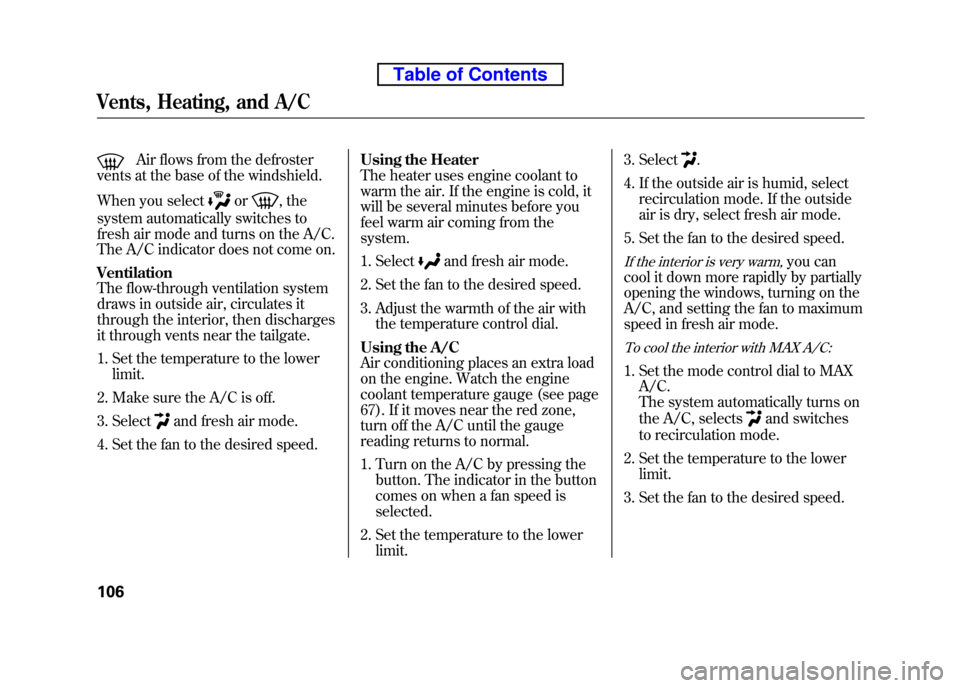
Air flows from the defroster
vents at the base of the windshield.
When you select
or, the
system automatically switches to
fresh air mode and turns on the A/C.
The A/C indicator does not come on. Ventilation
The flow-through ventilation system
draws in outside air, circulates it
through the interior, then discharges
it through vents near the tailgate.
1. Set the temperature to the lower limit.
2. Make sure the A/C is off.
3. Select
and fresh air mode.
4. Set the fan to the desired speed. Using the Heater
The heater uses engine coolant to
warm the air. If the engine is cold, it
will be several minutes before you
feel warm air coming from the system.
1. Select
and fresh air mode.
2. Set the fan to the desired speed.
3. Adjust the warmth of the air with the temperature control dial.
Using the A/C
Air conditioning places an extra load
on the engine. Watch the engine
coolant temperature gauge (see page
67). If it moves near the red zone,
turn off the A/C until the gauge
reading returns to normal.
1. Turn on the A/C by pressing the button. The indicator in the button
comes on when a fan speed isselected.
2. Set the temperature to the lower limit. 3. Select
.
4. If the outside air is humid, select recirculation mode. If the outside
air is dry, select fresh air mode.
5. Set the fan to the desired speed.
If the interior is very warm,you can
cool it down more rapidly by partially
opening the windows, turning on the
A/C, and setting the fan to maximum
speed in fresh air mode.
To cool the interior with MAX A/C:
1. Set the mode control dial to MAX A/C.
The system automatically turns on
the A/C, selects
and switches
to recirculation mode.
2. Set the temperature to the lower limit.
3. Set the fan to the desired speed.
Vents, Heating, and A/C
106
Table of Contents
Page 213 of 342
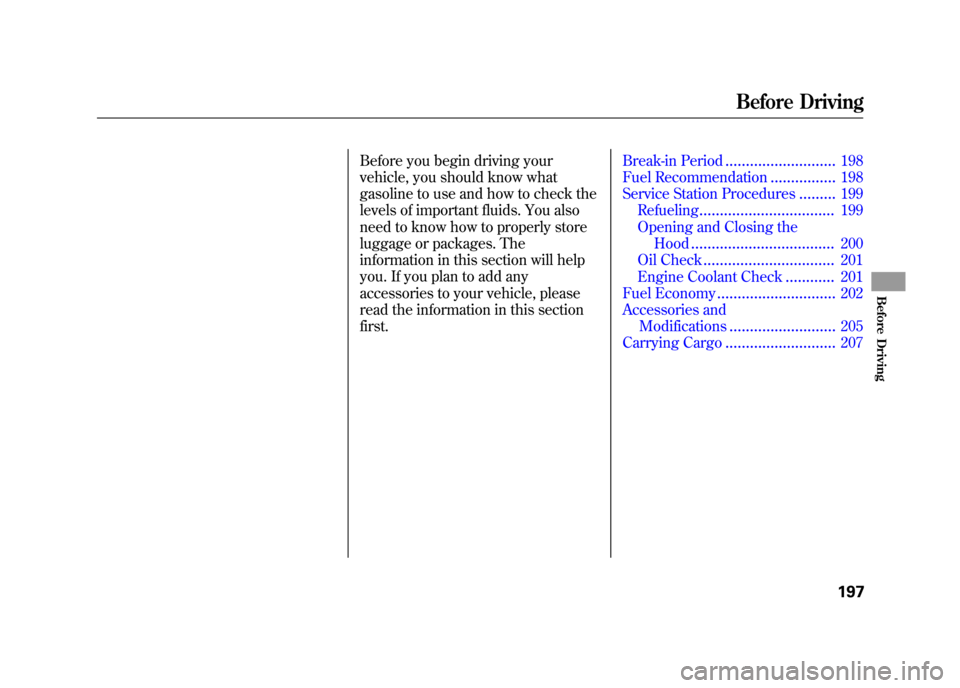
Before you begin driving your
vehicle, you should know what
gasoline to use and how to check the
levels of important fluids. You also
need to know how to properly store
luggage or packages. The
information in this section will help
you. If you plan to add any
accessories to your vehicle, please
read the information in this section first.Break-in Period........................... 198
Fuel Recommendation ................
198
Service Station Procedures .........199
Refueling .................................
199
Opening and Closing the Hood ................................... 200
Oil Check ................................ 201
Engine Coolant Check ............201
Fuel Economy .............................
202
Accessories and Modifications .......................... 205
Carrying Cargo ........................... 207
Before Driving
197
Before Driving
Page 217 of 342
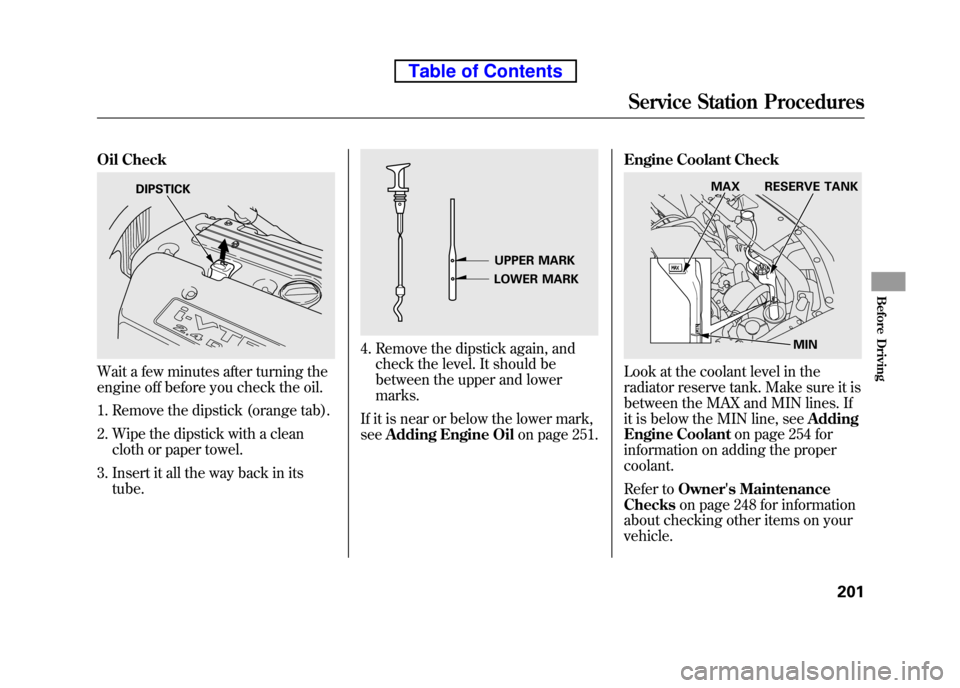
Oil Check
Wait a few minutes after turning the
engine off before you check the oil.1. Remove the dipstick (orange tab).
2. Wipe the dipstick with a clean cloth or paper towel.
3. Insert it all the way back in its tube.
4. Remove the dipstick again, andcheck the level. It should be
between the upper and lowermarks.
If it is near or below the lower mark,see Adding Engine Oil on page 251.Engine Coolant Check
Look at the coolant level in the
radiator reserve tank. Make sure it is
between the MAX and MIN lines. If
it is below the MIN line, see
Adding
Engine Coolant on page 254 for
information on adding the propercoolant.
Refer to Owner's Maintenance
Checks on page 248 for information
about checking other items on your vehicle.
DIPSTICK
UPPER MARK
LOWER MARK
MIN
MAX RESERVE TANK
Service Station Procedures
201
Before Driving
Table of Contents
Page 257 of 342
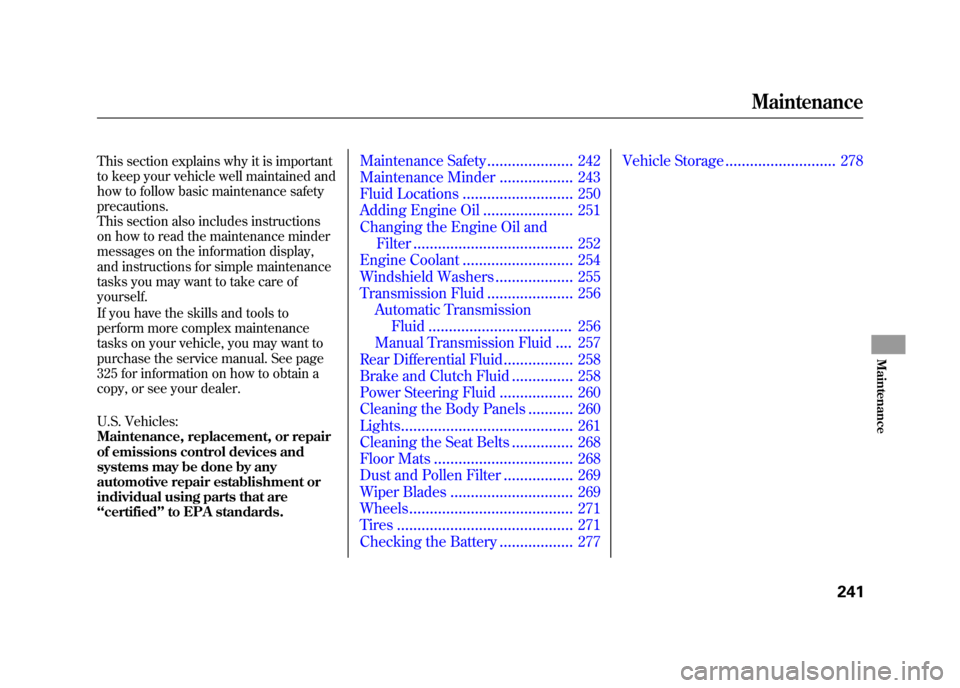
This section explains why it is important
to keep your vehicle well maintained and
how to follow basic maintenance safety
precautions.
This section also includes instructions
on how to read the maintenance minder
messages on the information display,
and instructions for simple maintenance
tasks you may want to take care of
yourself.
If you have the skills and tools to
perform more complex maintenance
tasks on your vehicle, you may want to
purchase the service manual. See page
325 for information on how to obtain a
copy, or see your dealer.
U.S. Vehicles:
Maintenance, replacement, or repair
of emissions control devices and
systems may be done by any
automotive repair establishment or
individual using parts that are‘‘certified ’’to EPA standards.Maintenance Safety .....................242
Maintenance Minder ..................
243
Fluid Locations ........................... 250
Adding Engine Oil ......................
251
Changing the Engine Oil and Filter ....................................... 252
Engine Coolant ........................... 254
Windshield Washers ...................255
Transmission Fluid .....................
256
Automatic Transmission Fluid ................................... 256
Manual Transmission Fluid ....257
Rear Differential Fluid .................
258
Brake and Clutch Fluid ...............258
Power Steering Fluid ..................
260
Cleaning the Body Panels ...........260
Lights .......................................... 261
Cleaning the Seat Belts ...............
268
Floor Mats .................................. 268
Dust and Pollen Filter .................
269
Wiper Blades .............................. 269
Wheels ........................................
271
Tires ........................................... 271
Checking the Battery ..................277Vehicle Storage
...........................
278
Maintenance
241
Maintenance
Page 264 of 342
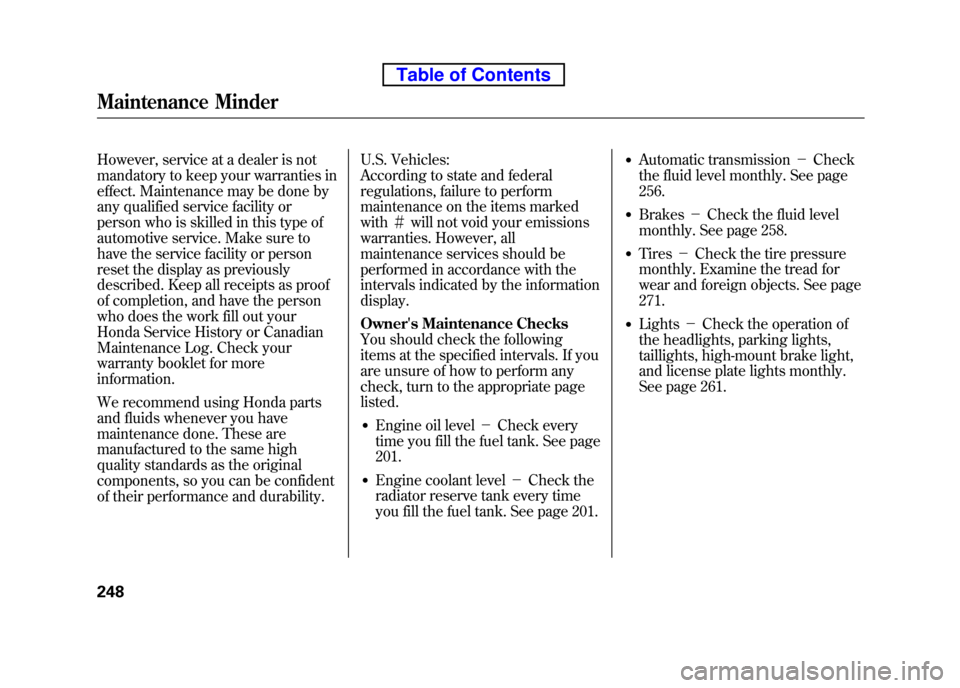
However, service at a dealer is not
mandatory to keep your warranties in
effect. Maintenance may be done by
any qualified service facility or
person who is skilled in this type of
automotive service. Make sure to
have the service facility or person
reset the display as previously
described. Keep all receipts as proof
of completion, and have the person
who does the work fill out your
Honda Service History or Canadian
Maintenance Log. Check your
warranty booklet for moreinformation.
We recommend using Honda parts
and fluids whenever you have
maintenance done. These are
manufactured to the same high
quality standards as the original
components, so you can be confident
of their performance and durability.U.S. Vehicles:
According to state and federal
regulations, failure to perform
maintenance on the items marked with
#will not void your emissions
warranties. However, all
maintenance services should be
performed in accordance with the
intervals indicated by the informationdisplay.
Owner's Maintenance Checks
You should check the following
items at the specified intervals. If you
are unsure of how to perform any
check, turn to the appropriate pagelisted.
● Engine oil level -Check every
time you fill the fuel tank. See page201.
● Engine coolant level -Check the
radiator reserve tank every time
you fill the fuel tank. See page 201. ●
Automatic transmission -Check
the fluid level monthly. See page256.
● Brakes -Check the fluid level
monthly. See page 258.
● Tires -Check the tire pressure
monthly. Examine the tread for
wear and foreign objects. See page271.
● Lights -Check the operation of
the headlights, parking lights,
taillights, high-mount brake light,
and license plate lights monthly.
See page 261.
Maintenance Minder
248
Table of Contents
Page 265 of 342
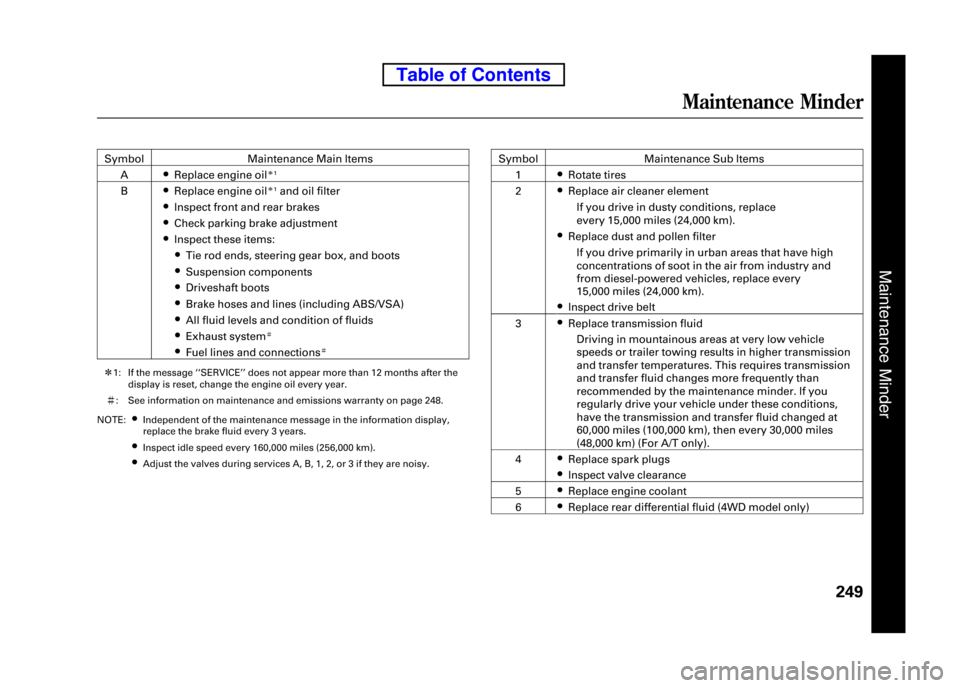
Symbol Maintenance Main ItemsA ●
Replace engine oilꭧ1
B ●
Replace engine oilꭧ1and oil filter
● Inspect front and rear brakes
● Check parking brake adjustment
● Inspect these items:
● Tie rod ends, steering gear box, and boots
● Suspension components
● Driveshaft boots
● Brake hoses and lines (including ABS/VSA)
● All fluid levels and condition of fluids
● Exhaust system
#
●Fuel lines and connections#
ꭧ1: If the message ‘‘SERVICE ’’does not appear more than 12 months after the
display is reset, change the engine oil every year.
# : See information on maintenance and emissions warranty on page 248.
NOTE: ●
Independent of the maintenance message in the information display,
replace the brake fluid every 3 years.
● Inspect idle speed every 160,000 miles (256,000 km).
● Adjust the valves during services A, B, 1, 2, or 3 if they are noisy. Symbol Maintenance Sub Items
1 ●
Rotate tires
2 ●
Replace air cleaner element
If you drive in dusty conditions, replace
every 15,000 miles (24,000 km).
● Replace dust and pollen filter
If you drive primarily in urban areas that have high
concentrations of soot in the air from industry and
from diesel-powered vehicles, replace every
15,000 miles (24,000 km).
● Inspect drive belt
3 ●
Replace transmission fluid
Driving in mountainous areas at very low vehicle
speeds or trailer towing results in higher transmission
and transfer temperatures. This requires transmission
and transfer fluid changes more frequently than
recommended by the maintenance minder. If you
regularly drive your vehicle under these conditions,
have the transmission and transfer fluid changed at
60,000 miles (100,000 km), then every 30,000 miles
(48,000 km) (For A/T only).
4 ●
Replace spark plugs
● Inspect valve clearance
5 ●
Replace engine coolant
6 ●
Replace rear differential fluid (4WD model only)
Maintenance Minder
Maintenance Minder
249
Table of Contents
Page 266 of 342
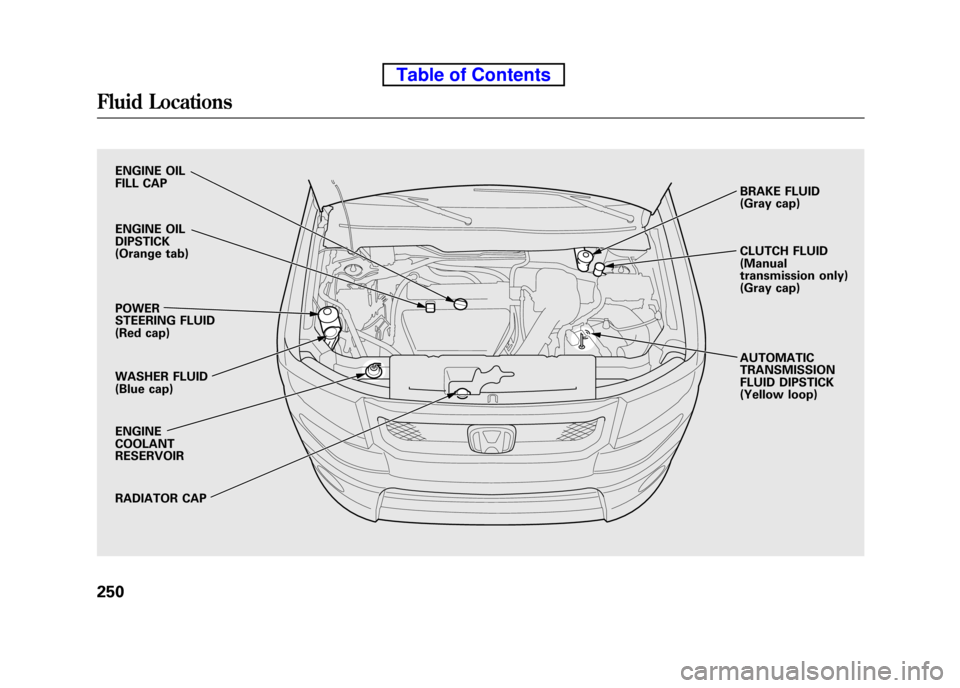
ENGINE OIL
FILL CAP
ENGINE OIL DIPSTICK
(Orange tab) POWER
STEERING FLUID
(Red cap)
WASHER FLUID
(Blue cap) ENGINE COOLANTRESERVOIR
RADIATOR CAPBRAKE FLUID
(Gray cap)
CLUTCH FLUID (Manual
transmission only)
(Gray cap) AUTOMATIC TRANSMISSION
FLUID DIPSTICK
(Yellow loop)
Fluid Locations
250
Table of Contents